Japan Wood Products
Prices
Dollar Exchange Rates of 25th
January 2016
Japan Yen 117.65
Reports From Japan
BoJ attempts another adventure – negative
interest
rates
Turbulence in stock markets around the world and news
that Chinese economic growth rates continue to slide unnerved
investors who rushed to the ‘safe-haven’ currency,
the yen.
Since the opening of trade in January the yen has risen
over 3% against the dollar making it one of the best
performing currencies for the year so far. A rising yen and
falling prices are not good for exporters but suppliers to
Japan welcome the slightly stronger yen hoping that
demand for imports will follow.
The government and Bank of Japan (BoJ) was warned by
many Japanese analysts that the rapid strengthening of the
yen threatens to undermine the gains made in stabilising
the economy and there were calls the Bank to act.
Clearly the Bank of Japan got the message as it surprised
economists and traders alike by adopting negative interest
rates for the first time ever at its 26 January meeting. This
unprecedented move came as pressure mounted on the
Bank to get the exchange rate and overall economy back
on track.
The BoJ will apply a rate of minus 0.1% on money lodged
by commercial banks at the BoJ and said further
reductions in rates are possible. A negative rate should
drive banks to lend more and should result in consumers
spending more because if they save the value of saving
will fall.
The move by the BoJ had an immediate impact on the
yen/dollar exchange rate. Over the past two weeks the yen
had strengthened which undermined confidence of
exporters. From yen 117 to the dollar on 25 January the
rate fell to 121 on 26 January.
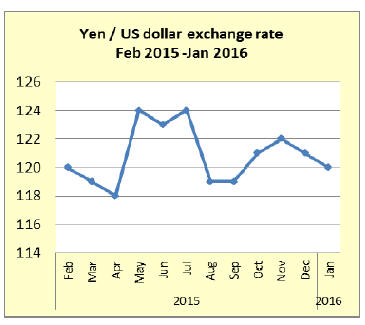
Sales of high priced homes rise but, prices for
cheaper
homes fall
House prices in Tokyo and to a lesser extent in other major
cities in Japan are rising so fast as to become out of reach
of most ordinary buyers and this is driving down overall
sales of both new and second hand homes.
Japan’s Real Estate Economic Institute (REEI) data
illustrates the anomalies in the market. While apartment
prices in Tokyo rose over 9% to a five year high last year
and the number of people making offers on homes fell by
around 10%.
REEI data shows that sales of properties priced at yen 100
million or more rose over 80% while cheaper homes
(under yen 50 million) fell by almost 20%.
Extremely low interest rates combined with profits from
gains in Japan’s stock market last year increased the
amount of cash available to the wealthier segment of
society who turned to the property market as a secure
investment. This caused prices to rise beyond the reach of
the normal family.
Steep declines in stock values this year has un-nerved
investors and even though the big banks have cut
mortgage interest rates this may not be enough to sustain
prices so property developers may be in for tough times.
For house price data see:
http://www.reinet.or.jp/en/
Ministry of Land, Infrastructure, Transport and Tourism
statistics on housing starts show an unexpected decline in
December 2015 after the advance made in November.
Year on year December housing starts fell almost 1.5% in
sharp contrast to the gain forecast by analysts. For the
calendar year 2015 housing starts came in at 901,300 up
just 1% compared to the January to December period in
2014. On the bright side, construction companies continue
to report healthy order book positions.
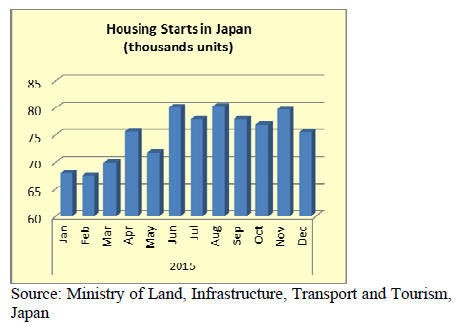
Import round up
Doors
Year on year November 2015 door imports continued
upward by another 14%, marking the fourth monthly gain
in 2015. China remains the main wooden door supplier at
64% off total door imports to Japan followed by the
Philippines.
Malaysia became the third ranked supplier in November
displacing Indonesia. The top three suppliers accounted
for around 85% of all wooden door imports in November,
a slight drop from October.
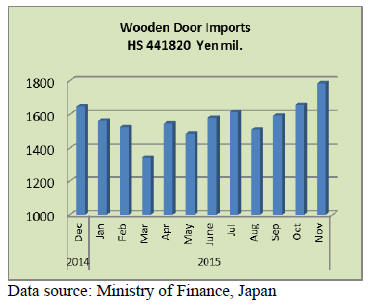
Windows
In November 2015 the top suppliers of wooden windows
to Japan were China and the Philippines together
accounting for approximately 64% of all wooden widow
imports. This was a significant drop on the 70% share the
two held in October and is explained by shipments of
wooden windows from the US to Japan.
China remains the main supplier of wooden windows to
Japan at 35% of all wooden window imports. November
2015 imports of wooden windows were the highest for the
past twelve months.
Year on year November imports were up 27% the same
rise as seen in October.
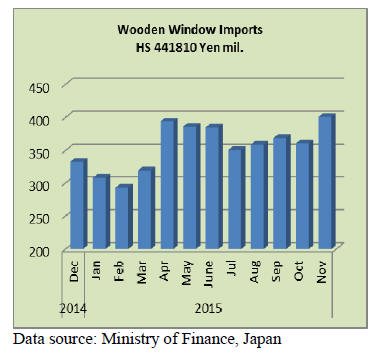
Assembled flooring
Year on year, Japan’s November 2015 imports of
assembled flooring continued downwards but compared to
October then imports in November rose sharply.
As in previous months China alone accounted for the
lion’s share of imports of this product (69% in November).
Japan’s November 2015 imports of assembled flooring
were from three main suppliers, Indonesia, Malaysia and
Vietnam but all together these three suppliers could only
capture just over 7% of Japan’s November import
requirements.

Plywood
The top three supply countries, China, Malaysia and
Indonesia account for the bulk (85%) of Japan’s plywood
imports.
The volume of plywood imports in November 2015 was
down 23% year on year. While the level of imports from
China stayed flat in November, sharp declines were seen
in the volume of imports from Malaysia (-17%) and
Indonesia (23%).

Trade news from the Japan Lumber Reports (JLR)
For the JLR report please see:
http://www.n-mokuzai.com/modules/general/index.php?id=7
New Olympic National Stadium plan selected
The original plan for the National Stadium for the 2020
Tokyo Olympic Games were withdrawn in last July due to
extreme high cost then there are two new proposals. The
Ministers Conference selected plan A in late December.
The new stadium has theme of ‘wood and green’ and the
roof is hybrid structure with combination of steel and
wood.
Wood is laminated lumber made of all domestic officially
certified wood. Use of large amount of wood for the
Olympic Stadium should trigger building of more wooden
structures and common use of certified wood in Japan.
The new plan includes traditional Japanese design.
Structural laminated lumber of both cedar E65-F225 and
larch E95-F270 are used for the roof.
Materials are medium sized laminated lumber of 120x450
mm with length of less than 6 meters, which can be
manufactured by any domestic laminated lumber plants.
Total of 1,800 cbms of laminated lumber will be procured.
Use of forest certified products is inherited from the
London Olympic.
Demand projection of imported wood products in 2016
The Timber Supply and Demand Conference of Japan,
which is formed by five groups of imported wood
products, came up with the projection of demand for 2016.
According to the projection, there will not be any
significant change on both import of logs and lumber.
Housing starts are expected to exceed over 2015 then they
would decline again in 2017 so imports of wood products
are likely to decline again in 2017.
Total demand for imported logs and lumber is 9,608,000
cbms, almost the same as 2015. New housing starts in
2016 are estimated about 940,000 units as opposed to 910-
920,000 units in 2015, about 2-3 % increase. Rush-in
demand before the consumption tax increase to 10%
starting April of 2017 seems to be insignificant.
Noticeable change is import of North American logs,
which is estimated to increase by 2.6%. It decreased by
15% in 2015 from 2014, which was too much so this
seems to be recovering increase. Shifting to domestic
species and production curtailment by plywood mills in
2015 resulted in decrease of
North American logs
New Zealand radiate pine import seems to decline further
in 2016 because of high export log prices influenced by
Chinese market. Crating lumber demand seems to be
shifting to domestic species.
Demand for Russian logs continues shrinking as sawmills
cutting Russian logs continue decreasing. Russian lumber
volume is stabilizing at about 600,000 cbms.
Plywood
On domestic softwood plywood, the supply tightness
continues by demand increase. Since last fall, precutting
plants enjoys full operations so that plywood mills also
continue a full production.
Delay of deliveries by plywood mills got worse toward
December. Therefore, total plywood mills’ production in
October was 244,100 cbms then November was 232,400
cbms while the shipment in October was 244,100 cbms
and November was 243,300 cbms so that the inventories
dropped by 10,000 cbms every month and November end
inventories were down to 120,000 cbms compared to the
peak of last year in May with 261,400 cbms.
Every plywood mills’ inventories are down to less than
two weeks. In this situation, mills are bullish and increase
the sales prices. Present Tokyo market prices are about
890 yen per sheet delivered.
Meantime, imported South Sea hardwood plywood market
is weak because of declined demand. The shipment in the
market has been dull since last summer. Actually,
uncertainty increases month after month.
As a matter of fact, the prices dropped by one notch in last
December to move the inventories. Such weaker prices
made the market more sluggish and price spread between
actual cost and sales prices gets wider for the importers
and wholesalers. Problem is nobody knows how much
prices should be reduced to move the inventories
particularly when the actual demand is down so much.
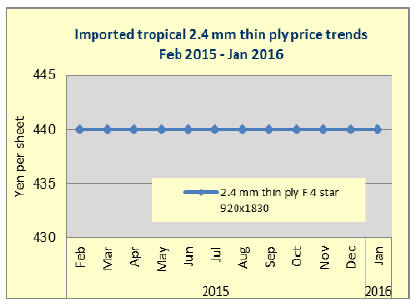

Toyama to build a new sawmill
Toyama Co., Ltd. (Miyazaki prefecture) has purchased a
property of 198,000 square meters to build a new domestic
species sawmill at Shibushi, Kagoshima prefecture. New
mill will be completed in middle of 2018. It intends to
recapture market share of domestic wood from imported
products and at the same time to aim export of lumber.
Toyama has three sawmills in Miyazaki prefecture with
state of the art sawmilling machines. Annual log
consumption is about 160,000 cbms.
The new mill would have 15% more production with
annual log consumption of 100,000 cbms. Once this new
lines start up, total log consumption by all the group mills
would be about 300,000 cbms.
The president Toyama says that quality of lumber should
be upgraded as time goes by so having higher grade and
precise delivery period are the priority matter to give
satisfaction to the customers. Production items are mainly
solid wood housing materials including cedar 2x4 lumber.
Facing declining trend of new housing starts, the company
intends to overcome by grabbing market share the
imported wood products have then hopes to start lumber
export since the mill situates close to the port of Shibushi,
which is the top wood exporting port in Japan.
|